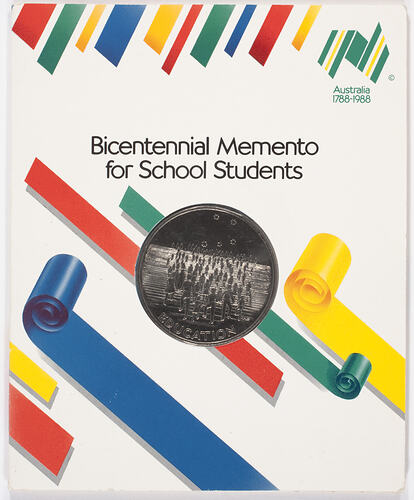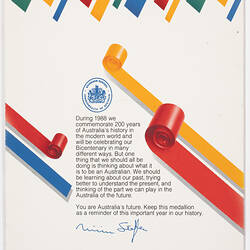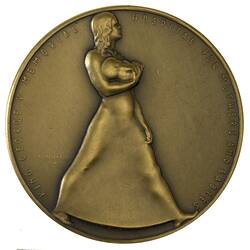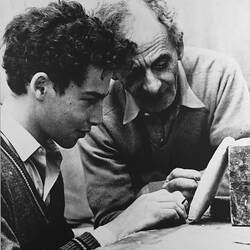Summary
Cupro-nickel medal in original presentation folder, commissioned by the Commonwealth of Australia to commemorate the Australian Bicentenary in 1988. Designed by Michael Meszaros and Michael Tracey and struck by the Royal Australian Mint in Canberra.
This medal, of which 3.2 million were struck, is believed by the artist to be the second-largest commemorative medal issue anywhere in the world. It was presented to schoolchildren throughout Australia to commemorate the Bicentenary in 1988. The obverse was designed by Melbourne artist Michael Meszaros and depicts school children climbing steps with the Southern Cross in the sky and the word 'EDUCATION' below. It took six attempts to find a design acceptable to the committee.The reverse, designed by Michael Tracey, features the Bicentennial logo, a map of Australia formed by parallel diagonal lines. It was given to the donor who was a Year 10 student at Fawkner High School in 1988.
Physical Description
Bicentennial medallion for school students, issued to Australian school students in 1988. The medallion is designed by two artists. On the obverse, designed by M. Nazaros; the reverse by M. Tracey. It was given to the donor who was a Year 10 student at Fawkner High School in 1988. It is presented in its original folder.
Significance
For over half a century, sculptors Andor (1900-1973) and Michael (1945- ) Meszaros have created medals that reflect the high points of life in Australia. From major awards and portraits of eminent Australians to artwork celebrating popular culture and the natural world, these objects illuminate our culture and history. Grounded in a centuries-old European art tradition, the medals create connections across disciplines and link such diverse subjects as scientific advances, religious themes, sport, the performing arts and motherhood. Through their public and private commissions and their personal artworks, the Meszaros sculptors have defined the modern Australian medal.
More Information
-
Collection Names
-
Collecting Areas
-
Acquisition Information
Donation from Mr Scott Killeen, 26 Sep 1999
-
Issued By
Commonwealth of Australia, Canberra, Australian Capital Territory, Australia, 1988
-
Mint
Royal Australian Mint, Canberra, Canberra, Australian Capital Territory, Australia, 1988
-
Artist
Michael Meszaros, 15 Laver St, Kew, Victoria, Australia, 1988
-
Manufacturer
Concept Studios Pty. Ltd., Australia, 1988
Of Folder -
Place & Date Issued
-
Inscriptions
Text: Australia/1788-1988/Bicentennial Memento/for School Students.
-
Classification
-
Category
-
Discipline
-
Type of item
-
Overall Dimensions
14 cm (Length), 11.4 cm (Width)
-
Keywords
Australian Bicentenary, 1788-1988, Celebrations, Civic Mementoes, Education, Keepsakes, School Children, Souvenirs





